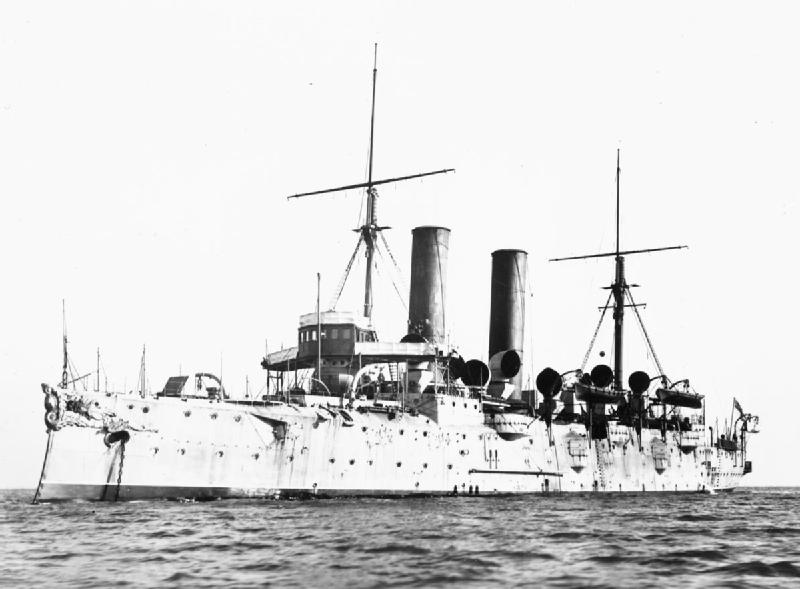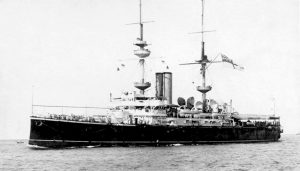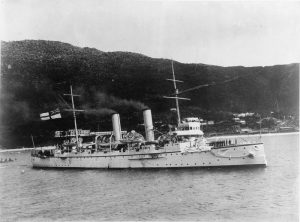Military unit: Royal Navy
Date & place of birth: 22 July 1872 at High Street, Southampton
Date & place of death: 4 November 1917 (aged 45) at Haslar Naval Hospital, Gosport, Hampshire
Felix Abraham was the son of a Southampton watchsmith and jeweller. He spent his entire adult life in the Royal Navy and became ill through the exertion of his naval duties and died following a few days in hospital.
Family
Felix Abraham was born on 22 July 1872 at 147 High Street, Southampton, the ninth child and youngest son of Henry Abraham (c. 1824–1881) and his wife, Mary Ann née Docwra (1832–1907).
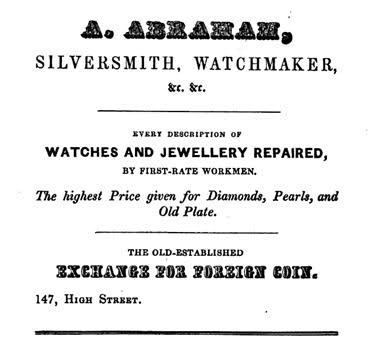 The Abraham family had traded as watchmakers and jewellers from their shop at 147 High Street (described as “exactly opposite St. Lawrence’s Church”) since 1826. This area, south of Bargate was heavily bombed in the Second World War and 147 High Street was destroyed in the Blitz, while St. Lawrence’s Church was demolished in 1925.
The Abraham family had traded as watchmakers and jewellers from their shop at 147 High Street (described as “exactly opposite St. Lawrence’s Church”) since 1826. This area, south of Bargate was heavily bombed in the Second World War and 147 High Street was destroyed in the Blitz, while St. Lawrence’s Church was demolished in 1925.
Henry Abraham had entered the family business as a young man and succeeded his father, Abraham Abraham (1799̅–1887) in June 1846. On 6 August 1857, he married Mary Ann Docwra at All Saints Church (which stood on the corner of High Street and East Street, a short distance south of the Bargate; it was also destroyed in the Blitz). Mary Ann was the daughter of Robert Docwra, the proprietor of the Crown Hotel in Southampton High Street.
The couple’s first child, George, was born in the spring of 1858 followed by a further ten children over the next 20 years. Like his father, Henry was a town councillor, becoming Mayor of Southampton in 1876–77, Deputy-Chairman of the Pier and Harbour Board and served in the 2nd Hampshire Rifle Volunteers.
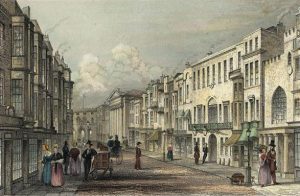
Henry Abraham died on 17 July 1881 leaving an estate of £7591, with his widow as executrix. Felix’s mother, Mary died on 29 April 1907, still living at 147 High Street. Her estate was valued at £7353, with probate being granted to her two eldest sons, George and Harry.
Felix Abraham completed his education at Hope House School conducted by Thomas Henry Vickery at Green Street, Southsea. This school was described by Rudyard Kipling in ‘A Very Young Person’ as a “terrible little day-school”; Kipling had been a pupil at the school in the 1870s. Felix was one of three students from the school to successfully pass the examinations for assistant clerkships in the Royal Navy in July 1889.
On 26 May 1914, Felix ‘gave away’ his younger sister, Isabel, at her wedding to Commander (later Rear Admiral) Algernon Chester Candy at St Mark’s Church in Archers Road, Southampton.
Felix Abraham appears to have never married.
Masonic career
Abraham Abraham was initiated into Royal Clarence Lodge No 523 at Frome in Somerset (where he was in partnership with his father, Moses) on 15 December 1823, but resigned from the lodge in 1826, when he moved to Southampton following which the partnership was dissolved. On 10 May 1827, Abraham was a joining member of Royal Gloucester Lodge No 212 (No 152 from 1832 and No 130 since 1863). He proceeded to become treasurer of the lodge in 1836 and to be installed as Worshipful Master in 1838, later becoming Provincial Junior Grand Warden in the Province of Hampshire.
Henry Abraham was initiated into Royal Gloucester Lodge No 152 on 27 December 1847 (meeting at Bugle Street, Southampton) and remained a member of the lodge until his death in 1881.
Felix followed his father and grandfather into Freemasonry during his service with the Royal Navy. He was initiated into Pinelands Kilwinning Lodge No 960 S.C, at Pinelands, Cape Town in South Africa. The lodge records are not available and his Masonic documents were lost at sea, although it is probable that he was initiated sometime after 1909, when he arrived at Cape Town on board HMS Forte, and before 1911 when he returned to Portsmouth.
In November 1916, Felix was proposed as a joining member of Royal Gloucester Lodge No 130, now meeting at Albion Place, Southampton. At the time, he was recorded as residing at the Polygon House Hotel. He joined the lodge on 10 May 1917.
Military service
Felix Abraham enlisted in the Royal Navy on 15 July 1889, a week before his 17th birthday. He spent his first two months with the service as a trainee clerk on board HMS Duke of Wellington (a ship of the line originally commissioned in 1853 and now the flagship of Admiral Sir John Edmund Commerell) based at Portsmouth, followed by two months with HMS Northumberland (a battleship 3rd Class commissioned in 1868) serving with the Coast Guard service at Portland, before transferring to HMS Imperieuse (a twin-screw armoured cruiser 1st Class commissioned in 1886) on 30 November 1889.
On 6 February 1890, he was transferred to HMS Hyacinth (a screw cruiser 3rd Class commissioned in 1884), where he served until 21 October on the China station.
Having received first class marks in his exams, he was appointed as a clerk on 15 July 1890, before transferring to HMS Victor Emmanuel (commissioned in 1858 and now serving as a receiving ship and hospital) on 22 October 1890 at Hong Kong. He remained on Victor Emmanuel until 4 November 1892, when he was ordered to return to England on medical grounds. (The records do not give any indication of the nature of his medical condition.)
During his service with the Royal Navy, he received regular assessments from his senior officers who generally reported highly favourably with comments such as ‘Young, painstaking & promising̊’, ‘Zealous in the performance of his duties’ and ‘Very reliable, good officer’. He was also reported as good at French and Drawing, a strong swimmer and as ‘Very fond of sports’.
By 21 April 1893, he had recovered from his illness and was appointed to serve on HMS Nelson (a twin-screw cruiser 1st Class commissioned in 1881, now a port guard ship in Portsmouth).
On 22 July, he passed his final exams and was promoted to the rank of Assistant Paymaster, after which he was transferred to another Portsmouth-based guard ship, HMS Inflexible (a twin-screw battleship 2nd Class commissioned in 1891) on 26 November 1893.
Six months later, on 26 May 1894, Felix returned to the sea when he transferred to the newly-commissioned HMS Blenheim (a twin screw cruiser 1st Class based at Chatham) with the Channel Squadron, under the command of Captain (later Admiral) Edmund S. Poē.
In December 1894, the Canadian Prime Minister Sir John Thompson died in England and was repatriated to Halifax, Nova Scotia by Blenheim, which was painted black for the occasion. In January 1896, Prince Henry of Battenberg died from malaria while on active duty on board HMS Blonde off Sierra Leone; Blenheim repatriated his body from the Canary Islands. (His son, Prince Maurice, the grandson of Queen Victoria, was the reigning Worshipful Master of Twelve Brothers Lodge, No 785 of Southampton when he was killed near Ypres on 27 October 1914.)
On 26 June 1897, Felix was on board HMS Blenheim during the Spithead review to commemorate the Diamond Jubilee of Queen Victoria.
The following month, on 27 July, he transferred to HMS Renown, a Centurion class battleship which had been commissioned on 8 June 1897. She was briefly attached to the 1st Division, of the Channel Squadron for manoeuvres off the south coast of Ireland. On 24 August, Renown became Rear Admiral ‘Jacky’ Fisher’s flagship, on the North America and West Indies Station. The ship continued as such until beginning a refit in May 1899, when Felix was briefly transferred to HMS Edgar and then HMS Thames, before re-joining HMS Duke of Wellington (where he had spent his first two months in the Royal Navy ten years earlier) on 29 August 1899.
From January 1901 to February 1902, Felix was serving on HMS Cockatrice (a gunboat 1st Class launched in 1886) based at Chatham before joining HMS Australia (a twin screw cruiser 1st Class commissioned in 1888) based in Southampton Water as a coastguard ship. On 16 August 1902, Australia took part in the fleet review held at Spithead for the coronation of King Edward VII.
Felix continued to receive favourable reports during his service with the Royal Navy. In November 1902, Captain George Neville of HMS Australia described him as ‘Zealous’ and of ‘Good physique’, recommending him for promotion.
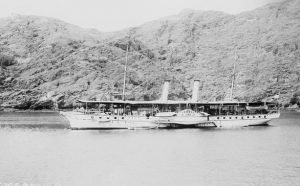
On 26 November 1902, Felix transferred to HMS Sphinx (a composite paddle vessel launched in 1882 and re-commissioned in Bombay in May 1902) serving in the Far East, on which he served until 22 March 1905, having been promoted to Paymaster on 1 March 1903.
From June 1905 to February 1906, he was on HMS Repulse (a twin-screw battleship commissioned in 1894), part of the reserve fleet stationed at Chatham. In November 1905, Felix was admitted to hospital at Chatham (described as ‘sick’); he was discharged in January and returned to active service on 2 March 1906.
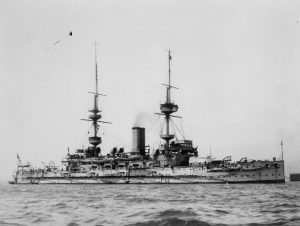
On 24 March 1906, Felix was transferred to the newly-commissioned HMS Illustrious (a twin-screw battleship), with the Channel Fleet, where he remained until 1 June 1908, having received further promotion to Staff Paymaster on 1 March 1907.
On 16 June 1908, Felix joined HMS Forte (a twin-screw protected cruiser 2nd Class commissioned in 1895), serving initially with the Home Fleet based at Portsmouth. Later that year, Forte, under the command of Captain (later Admiral Sir) John Green, performed extremely poorly in a gunlayer’s test; a court of inquiry faulted Green and the other officers of Forte for failing to provide sufficient training.
In late April 1909, HMS Forte was sent to South Africa, where she was based at Simon’s Town on the Cape Peninsula. Felix received his final promotion to Fleet Paymaster in South Africa on 1 March 1911. In April, Captain Green reported that Felix was ‘Zealous, correct & very musical’ and praised his ‘Good judgement, tact & physical qualities’.
As a Fleet Paymaster, Felix was equivalent in rank to that of Commander, one rank below that of Captain. While based with HMS Forte at Simon’s Town, Felix was one of 324 officers and crew recorded in the 1911 Census.
In April 1911, HMS Forte was re-commissioned at Simon’s Town at which time Felix transferred to HMS St George (a twin-screw protected cruiser, commissioned in March 1910) and returned to Portsmouth. He remained with the St George until September 1913, during which time he was engaged on victualling duties. In May 1912, Captain (later Vice Admiral) Vincent Molteno, described Felix as ‘Popular & [a] good shipmate’.
On 30 September 1913, he was transferred to the newly-commissioned HMS Audacious (a 23,000 ton battleship)part of the 2nd Battle Squadron stationed at Portsmouth. He remained with Audacious until 22 November 1914, when he was transferred to another newly-commissioned battleship, the HMS Queen Elizabeth. While these two new battleships were being commissioned, Felix was based onshore at Portsmouth.
On 8 April 1915, Felix was admitted to hospital in Plymouth with liver disease, and was transferred to Haslar Hospital near Gosport, Hampshire on 25 April, where he was found to have a malignant growth on his liver. He was placed on three months shore leave and re-examined on 9 August when he was placed on the Retired List as ‘physically unfit’.
On 23 September 1915, he was again examined to decide whether or not he was sufficiently fit to be appointed to the Transport Service at Southampton. The examination found him to be ‘unfit for service ashore’, but despite this he resumed light duties. After three months, it was reported that he was ‘standing the work well’ and had ‘improved in health’.
Death and commemoration
On 21 Sep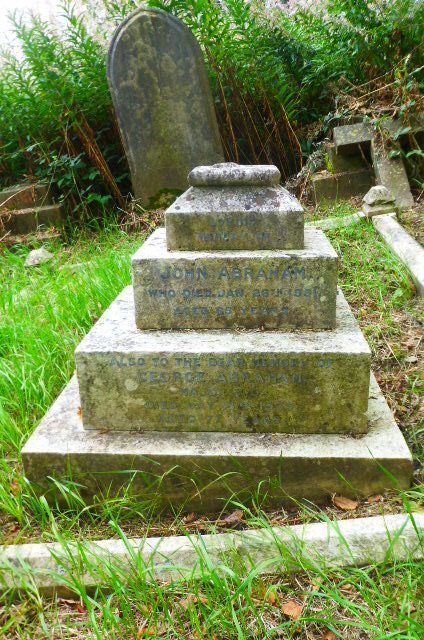 tember 1916, he was sufficiently well to be posted to join the shore based staff of HMS President, but little over a year later he was re-admitted to Haslar Hospital where he died on 4 November 1917. The cause of death recorded in the Royal Navy records was ‘lobar pneumonia’ although the history of Royal Gloucester Lodge attributes the cause of his illness to ‘the exertion of his naval duties’.
tember 1916, he was sufficiently well to be posted to join the shore based staff of HMS President, but little over a year later he was re-admitted to Haslar Hospital where he died on 4 November 1917. The cause of death recorded in the Royal Navy records was ‘lobar pneumonia’ although the history of Royal Gloucester Lodge attributes the cause of his illness to ‘the exertion of his naval duties’.
Felix Abraham was buried at Southampton Cemetery in Hill Lane on 15 November 1917, with full naval honours. The cortege travelled from the home of his brother at Alma Road with the coffin, covered with a union Jack and surmounted by Felix’s hat and sword, placed on a gun carriage drawn by four black horses. His body was interred alongside his mother who had died ten years earlier. At the conclusion of the service, three volleys were fired over the grave and the Last Post was sounded.
His estate was valued at £2737 with probate granted to his oldest brother, George. At the time of his death, he was resident at 45 Bugle Street, Southampton.
Felix Abraham is commemorated on the Southampton Cenotaph in Watts Park, Southampton.
Sources
Ancestry.co.uk
1881 England Census
1911 England Census
British Army and Navy Birth, Marriage and Death Records, 1730-1960
England & Wales, National Probate Calendar (Index of Wills and Administrations), 1858-1966
Navy Lists, 1888-1970
United Grand Lodge of England Freemason Membership Records, 1751–1921
CWGC Casualty Details: Fleet Paymaster Abraham, Felix
Daily Express (Dublin): 13 September 1893
Daily Telegraph: 31 August 1899. Naval Appointments
Find a Grave: Fleet Paymaster Felix Abraham
Hampshire Advertiser:
30 May 1914. Pretty Naval Wedding at Southampton
19 November 1917. Death of Fleet Paymaster Abraham
Hampshire Independent. 5 April 1887. Death of an Old Southamptonian
Hampshire Telegraph:
24 July 1897
10 June 1905
10 March 1906
15 August 1908
Jenkins, Roger. Royal Gloucester Lodge 130 History (2017)
Kindell, John. Royal Navy Roll of Honour – World War 1 (2009)
The Kipling Society Journal (September 1963)
Lloyd’s List:
22 April 1893. Royal Navy Appointments
12 May 1894. Royal Navy Appointments
The London Gazette:
10 March 1903 Issue: 27533 Page: 1596
5 March 1907 Issue: 28001 Page: 1575
3 March 1911 Issue: 28471 Page: 1635
17 August 1915 Issue: 29266 Page: 8158
Masonic Roll of Honour: Fleet Paymaster Felix Abraham
The National Archives:
ADM 196/82/415 Abraham, Felix Date of Birth: 22 July 1872 Rank: Fleet Paymaster
ADM 196/171/16 Abraham, Felix Date of Birth: 22 July 1872 Rank: Assistant Acting Paymaster
Portsmouth Evening News:
22 June 1889. Hope House School (Vickery’s)
4 March 1907. Naval Promotions
2 September 1913
Sheffield Daily Telegraph: 17 August 1915. Retirement
Sotonopedia:
Southampton Cenotaph: Fallen Heroes – Felix Abraham
Southampton City Council. List of Southampton Mayors 1217 to date
Southampton Old Cemetery: War Graves
Western Daily Mercury: 21 June 1889
Western Morning News: 15 November 1893. Naval Appointments
Wikipedia:
Photograph credits
High Street, Southampton in 1839: Wikipedia
HMS Blenheim: Wikimedia Commons
HMS Renown: Wikipedia
HMS Sphinx: www.medalsofengland.com
HMS Illustrious: Wikimedia Commons
HMS Forte: Wikimedia Commons
Gravestone: www.findagrave.com
